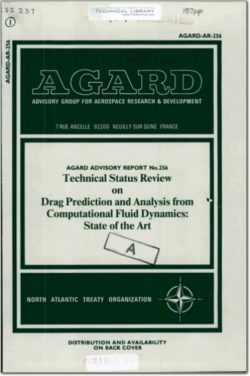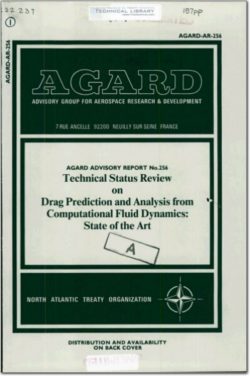AGARD-AR-256

- Version
- 297 Downloads
- 35.45 MB File Size
- 1 File Count
- March 8, 2016 Create Date
- March 8, 2016 Last Updated
Drag Prediction and Analysis from Computational Fluid Dynamics

In the past 10—-20 years Computational Fluid Dynamics (CFD) has emerged as an indespensible tool in aircraft design.
Methods based on linearized theory (Panel Methods) and Full Potential theory with or without inclusion of viscous effects
are being used on a routine basis in industry and research establishments. Methods based on the Euler equations and
Reynolds Averaged Navier-Stokes equations, at least for simple configurations, are approaching this status. The status is
reflected in, a.o., the proceedings (ref. 1) on “Applications of Computational Fluid Dynamics in Aeronautics", held in Aix-
en-Provence, in the spring of 1986.
One of several observations made at the Aix-en-Provence meeting (ref. 2).was that the computation of drag was given
only secondary treatment in almost all of the papers presented. This in spite of the importance of drag for aircraft
performance. In the Round Table Discussion terminating the Aix meeting both the accuracy of drag prediction and the
breakdown of drag into its basic components (viscous, induced and wave drag) emerged as being very important but not
satisfactorily dealt with. It was concluded that the topic should receive more attention in the future.
In order to stimulate such attention the FDP decided to organize a Technical Status Review (TSR) on the topic of “Drag
Prediction and Analysis from Computational Fluid Dynamics”.The primary objective was to obtain a survey of the state-of-
the-art in the NATO countries. The TSR was to take place in conjunction with the FDP Symposium on “Validation of
Computational Fluid Dynamics” to be held in the spring of 1988 in Lisbon because this symposium was expected to address
also the aspect of validation with respect to drag. Since the symposium was expected to draw a large audience it was decided
that the TSR would be of “open" character allowing all symposium participants to become aware of the current status of
CFD-based drag prediction. In this way attention to the subject would be stimulated within a large group of researchers.
| File | Action |
|---|---|
| AGARD-AR-256 Drag Prediction and Analysis from Computational Fluid Dynamics.pdf | Download |

Comment On This Post